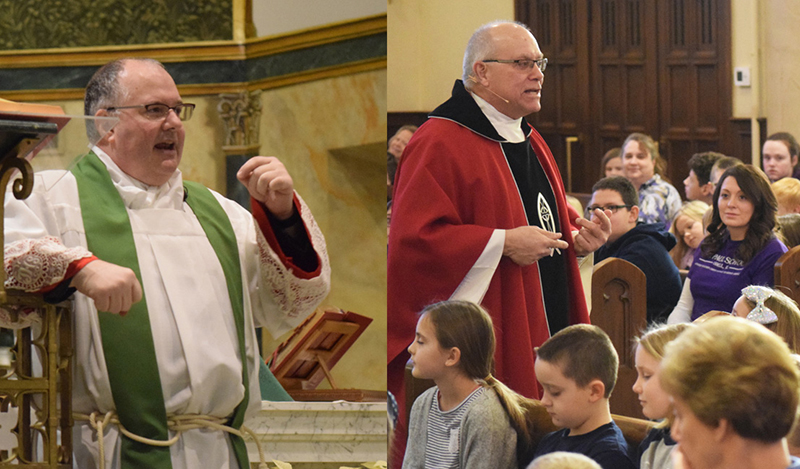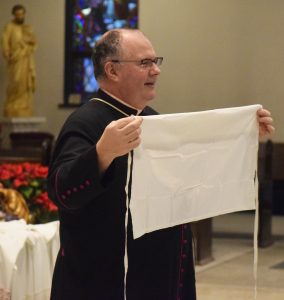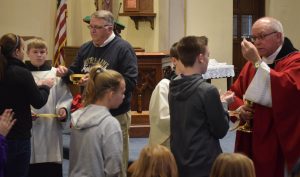Explanatory Masses at two parishes offer insights into ‘something heavenly’

Celebrating explanatory Masses in recent days were Msgr. Brian Brownsey (left) at St. Mark Church in Peoria and Father David Sabel at at Catholic Schools Week Mass at St. Mary Church in Pontiac. (The Catholic Post/Tom Dermody)
“What’s happening before your eyes is something heavenly,” said Msgr. Brian Brownsey prior to beginning the Eucharistic Prayer.
“This is the most important meal of our lives,” reminded Father David Sabel upon reaching the Liturgy of the Eucharist.
For one day at St. Mark Church in Peoria and St. Mary Church in Pontiac, the pastors repeatedly interrupted the familiar flow of the Mass to explain the “why” behind the words, actions, and environment of the sacred liturgy.

Msgr. Brownsey holds up the amice, one of the liturgical vestments worn by a priest. It is sometimes referred to as the “helmet of salvation.” (The Catholic Post/Tom Dermody)
“Explaining the Holy Mass is one of my very favorite ways to teach,” said Msgr. Brownsey, pastor of St. Mark, in welcoming area Catholics who nearly filled the church an hour before the 4:30 p.m. Mass on Jan. 28 to learn more about the history and meaning of the way we worship.
Attending such an explanatory Mass decades ago “absolutely changed everything” for him, said Msgr. Brownsey. “I pray you get the same kind of eye-opening from what you learn tonight.”
“HERE TO OFFER, NOT TO GET”
The approaches taken by the two priests were markedly different to match their assemblies. By starting an hour early, Msgr. Brownsey had time to go into deeper detail with mostly adult weekend Mass goers, while Father Sabel often asked questions as he celebrated a Catholic Schools Week Mass on Feb. 3 for students from St. Mary School and nearby St. Paul School in Odell.
But their major points of emphasis were similar, including that coming to Mass should be a profoundly different experience from attending a play or a sporting event.
“We’re here to offer, not to get,” said Msgr. Brownsey. Too many Catholics, he said, put the emphasis on “getting something out of” the Mass and may sometimes leave disappointed if the music or homily don’t match their expectations, for example.
“The primary reason you’re here is to offer yourself,” said Msgr. Brownsey. “It’s a sacrifice. Every minute of the day God is offering to you. The only appropriate response is to give yourself back.” He urged Catholics to come to every Mass with a specific intention.
Father Sabel echoed that message in explaining the offertory in Pontiac.
“When bringing up the bread and wine, you are also bringing up yourselves,” Father Sabel told the students. “You’re part of this offering. We want you to be transformed.”
“WE’RE NOT EATING BREAD”
Both pastors strongly urged Catholics not to refer to the consecrated Body and Blood of Christ as bread and wine.

“Nothing compares to the great gift of our Lord’s precious Body and Blood,” said Father Sabel, shown with Richard Morehouse distributing Communion to students from St. Mary School in Pontiac and St. Paul School in Odell. (The Catholic Post/Tom Dermody)
“We’re not eating bread,” said Father Sabel. “We’re not drinking wine. Nothing compares to the great gift of our Lord’s precious Body and Blood,” he added, explaining why such great care and reverence is taken with even the smallest particle or drop of the Eucharist after Communion.
Msgr. Brownsey pointed to the crucifix behind the altar and recalled the words of a child who described the difference between it and the Eucharist. “That looks like Jesus but is not really him,” said the child of the figure on the cross. “That looks nothing like Jesus but it really is,” she said of the Eucharist.
In fact, the Eucharistic Prayer “takes us into heaven,” said Msgr. Brownsey. “Once we begin the Eucharistic Prayer I’m actually standing in heaven,” he said.
Father Sabel said the Mass is “where the earthly church meets the heavenly church.”
FROM START TO FINISH
Both priests explained their liturgical vestments as they prepared for Mass. Beneath the outer vestment, known as a chasuble, are the amice, the alb, the cincture, and the stole — each with their own practical and spiritual meanings as they set the priest and his function apart as representing Christ.
Following are just a few of their comments as the priests moved through the various rites of the Mass:
- “There will be no services on Easter Sunday at St. Mark’s,” said Msgr. Brownsey. Why? “We have Mass. It’s different. A service is something that human beings come up with. Mass is not designed by human beings. Mass is given to us by Our Lord.”
- “Why do we bring up bread and wine? Why not beets and carrots?” asked Father Sabel. The bread, made from many individual pieces of wheat, represents our diversity, while the wine is a fruit of our labors and signifies celebration.
- Msgr. Brownsey called the Sign of Peace “a very serious time” before Communion that should not be taken lightly. If there is someone you need to forgive or seek forgiveness from, but they are not present, “turn to the person next to you, pretend they are the one you have in mind, and offer peace to them.”
- “Why would you leave before Our Lord gives you the final blessing?” asked Father Sabel. Stay till the end, he urged, because the final blessing is designed to send us forth, strengthened by the Eucharist, to build the kingdom of God.





